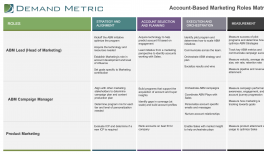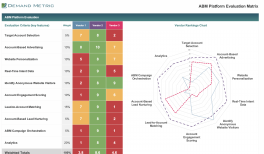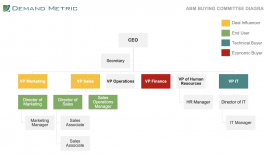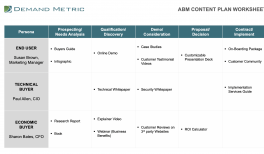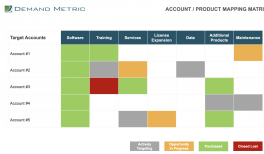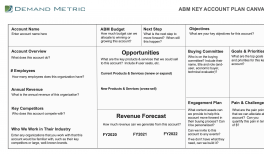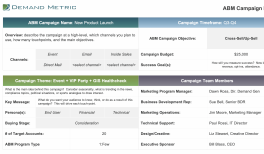Follow this simple step-by-step guide to develop an account-based marketing (ABM) approach and strategy.
ABM Strategy Playbook
Resource Overview
Related Resources
Our Account-Based Marketing (ABM) Strategy Playbook is a planning methodology that highlights our premium tools and templates to help you develop an ABM approach and strategy that supports your company’s goals & objectives.
Demand Metric playbooks are step-by-step guides that help you build strategic processes using "Best Practices" and other Demand Metric tools & templates. For more background on Demand Metric playbooks (aka methodologies), read our blog post: Much Ado About Methodologies
Stages of playbook include:
- Align Resources
- Select Accounts
- Generate Insights
- Create Plans
- Execute Campaigns
- Measure Results
There are 16 premium tools and templates linked inside of this playbook to facilitate the process:
- ABM Capabilities Assessment
- The State of the ABM Tech Stack Report
- ABM Roles Matrix
- ABM Program Budget Template
- Ideal Customer Profile Template
- ABM Account Tiers Worksheet
- Account Product Mapping Matrix
- Account Scoring Template
- Buyer Persona Template
- Decision Maker Influencer Map
- ABM Buying Committee Diagram
- ABM Content Plan Worksheet
- ABM Key Account Planning Canvas
- ABM Platform Evaluation Matrix
- ABM Campaign Planning Tool
- ABM Program Metrics Dashboard
All effective marketers know their job is to get the right message to the right person in the right way at the right time.
Account-based marketing is one specific way of doing exactly that in the B2B setting, and as such, it’s hardly a new idea. The coining of the term and associated buzz over the last five years is the result of new technologies that allow marketers to implement the strategy at scale.
Many have heard of ABM by other names: target account marketing or strategic account marketing.
ABM’s core characteristics include identifying a subset of high-potential accounts and collaborating with sales to personalize engagement with each account’s stakeholders, thereby closing deals on accounts that offer maximum bang for marketing department bucks.
Ultimately, it is a strategic B2B marketing approach that aligns sales and marketing efforts to target the right accounts, resulting in more meaningful and profitable customer engagement.


